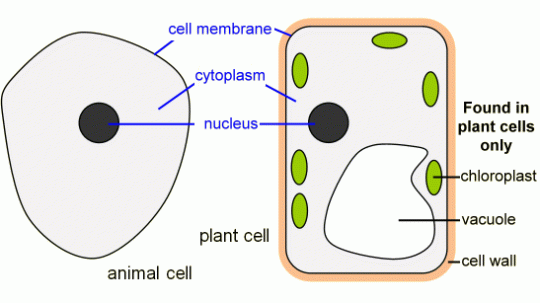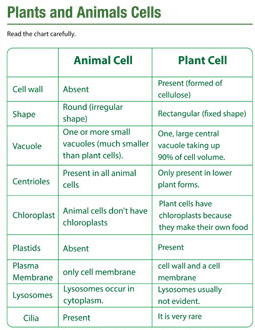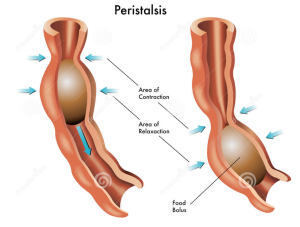Category: Section 2: Structures and Functions in Living Organisms
Starch Digestion: Grade 9 Understanding for IGCSE Biology 2.29
You must remember that “Digestion” has a specific meaning in Biology. It is the term used for the process that involves the chemical breakdown of large, insoluble food molecules into smaller, simpler molecules that can be absorbed into the blood. Many of the molecules in food are polymers – that is macromolecules made from long chains of repeating subunits. Examples of dietary macromolecules include proteins, polysaccharides and fats. These molecules are too large to be able to pass into the blood in the villi of the small intestine and so the body has evolved to chemically break them down into their constituent monomers or building blocks. Digestion is the process in the alimentary canal that achieves this.
Digestion reactions are also known as hydrolysis reactions because a molecule of water is required in the reaction to break the covalent bond holding the monomers together. These reactions are all catalysed (sped up) by specific molecules called digestive enzymes.
Why do different food types need different digestive enzymes to speed up their breakdown in the digestive system?
(If you are unsure, you need to revise the way enzymes work to catalyse reactions by a “lock and key” theory?)
Digestion of Carbohydrates
Many simple carbohydrates (e.g. glucose) do not need digesting. This is because they are already small enough to be absorbed into the blood directly in the ileum (small intestine). But larger disaccharide sugars (e.g. maltose and sucrose) do need to be broken down, as do all polysaccharides (e.g starch).
The family of enzymes that break down carbohydrates are called carbohydrases.
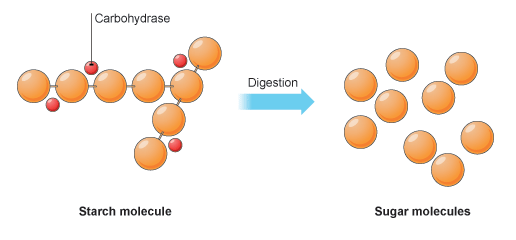
Starch is a large polysaccharide made up of many hundreds of glucose residues linked together. It is way too big to be able to cross the epithelial lining of the small intestine and so needs to be digested. This happens in a two-stage process. Firstly there is an enzyme amylase that can catalyse the following reaction:
starch + water ——-> maltose
Amylase is made in the salivary glands and so works in the mouth. But the main region for the digestion of starch is in the duodenum. This is because amylase is also made in the pancreas.
Maltose is a disaccharide molecule made of two glucose residues joined together. Maltose itself requires digesting to its constituent glucose molecules in order to be absorbed. So the second stage in the digestion of starch involves a second enzyme, maltase that is found embedded into the epithelial lining of the ileum. Maltase catalyses the breakdown of a molecule of maltose into two molecules of glucose which can be absorbed into the blood.
maltose + water ——> glucose

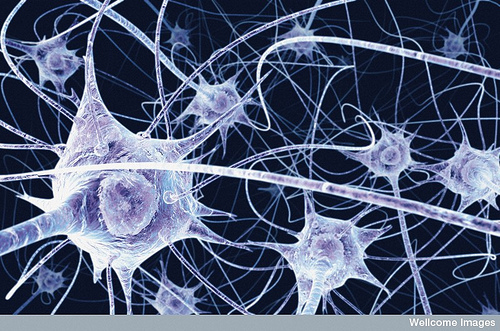
Cell Structure: Grade 9 Understanding for IGCSE Biology 2.2 2.3 2.4
All living organisms are made from cells. Indeed the cellular nature of life is one of the universal features shared by all life on earth. Some organisms are made from just one cell (unicellular organisms) while at some point around 1 billion years ago, cells starting clumping together and specialising to form multicellular organisms such as animals and plants.
What do all cells have in common?
All cells are surrounded by a cell membrane. The cell membrane is made from a mixture of proteins and a type of lipid called a phospholipid. The cell membrane serves many functions but perhaps the most significant is acting as a partially permeable barrier that can control which molecules can enter and leave the cell.
Inside the cell membrane there is a watery solution of chemicals called the cytoplasm. The cytoplasm is the site of many metabolic reactions in the cell because many enzymes are dissolved in the cytoplasm. The cytoplasm also contains many tiny nano machines for assembling proteins called ribosomes.
And that is about it for things all cells have in common. Prokaryote cells (bacteria) have a very different cell structure with no organelles but in this section you need to understand the simplified structure of two eukaryote cells: a typical animal (on the left below) and a typical plant cell (on the right).
Both animal and plant cells have a nucleus. This is the largest organelle and contains the DNA which is the genetic material. The DNA is found in long thread-like structures called chromosomes. The nucleus controls the division of the cell and also the various functions of the cell by regulating which proteins get made.
Animal and Plant cells both contain mitochondria which are the organelles associated with aerobic respiration. Mitochondria are recognisable in the cytoplasm of the cell as sausage-shaped organelles with a folded inner membrane (see diagram above).
Structures found only in Plant cells
1) All plant cells have a thick rigid cell wall made of the carbohydrate cellulose. The cell wall allows plant cells to become turgid since when the cell takes in water by osmosis, the rigid cell wall prevents the cell from bursting. The cell wall also acts as a transport pathway across plant tissues and can provide a barrier to some pathogens.
2) All plant cells have a large permanent central sap vacuole. This organelle is bounded by a membrane called the tonoplast and in many plant cells takes up the majority of the volume of the cell.
The sap vacuole provides a compartment in the cell into which excretory molecules can be moved to stop them poisoning the cytoplasm. It also plays a role in the water balance of plant cells since because of all the solute dissolved in it, the cell sap has a low water potential. This helps draw in water by osmosis from the cytoplasm and hence from outside the cell across the cell membrane.
3) Many but not all plant cells contain chloroplasts. These are organelles associated with the process of photosynthesis. Chloroplasts can be recognised in a light microscope image as small, green structures in the cell. The green pigment comes from the chlorophyll molecules that trap energy from sunlight. In an electron micrograph, chloroplasts are distinguished due to their stacks of membrane discs called grana.
Differences between plant and animal cells
The Human Alimentary canal: Grade 9 Understanding for IGCSE Biology 2.27
A human body is in many ways rather like a packet of polo mints. These are famous mints in the UK for having a hole in the middle. Our body is divided into segments (rather like the packet of polos) and we have a tube that runs through the middle of us. This tube is called the Alimentary Canal (or Gut) and it’s function in the body is the digestion and absorption of food molecules (see later post on “Stages of Processing Food”)
The Alimentary Canal is divided into specialised regions, each with its own particular range of functions to do with the processing of food. You are required to understand a little about some of these organs and their functions.
The first thing is to make sure you can label a diagram of the human digestive system such as the one shown above. Check that you could accurately identify the following structures:
mouth, tongue, teeth, salivary glands, oesophagus, stomach, liver, gall bladder, bile duct, pancreas, pancreatic duct, duodenum, ileum, colon, appendix, rectum, anus
Here is a good diagram to use to check your labelling of the human digestive system
Functions
1 Mouth
The mouth is actually the name for the opening at the top of the alimentary canal rather than the chamber behind. If you want to be really precise, you should call this chamber containing the tongue and teeth by its proper name, the buccal cavity. The mouth is the opening that allows an animal to ingest food. In the buccal cavity, the teeth can chop up the food into smaller pieces and the tongue can move the food into a ball (bolus) for swallowing. The food is tasted in the buccal cavity and there are many chemoreceptors on the tongue and in the nasal cavity that perform this function. There are three sets of salivary glands around the buccal cavity and these secrete a watery liquid, saliva to mix with the ingested food. Saliva is alkaline to help protect the tooth enamel from acidic decay by bacteria but also contains a digestive enzyme, salivary amylase that begins the process of digestion of starch in the mouth. Salivary amylase catalyses the hydrolysis reaction in which starch, a polysaccharide is digested into the disaccharide maltose.
2 Oesophagus
The oesophagus is the tube that carries the ball of food from the back of the throat through the thorax and down into the stomach. The Alimentary canal has layers of muscle in its wall throughout its entire length. These layers of smooth muscle can contract and relax in an antagonistic fashion to push the bolus along the tube. There are two main types of smooth muscle in the wall of the Alimentary canal – circular fibres are arranged around the circumference of the tube and longitudinal fibres are arranged along the length of the tube. These waves of alternate contraction and relaxation are called peristalsis.
3 Stomach
The stomach is a muscular storage organ that keeps food in it for around 3-4 hours before squirting it out in small amounts into the duodenum. The muscle layers in the stomach wall churn the food and mix it with the secretions from the stomach lining. These secretions are called gastric juice and contain a mixture of hydrochloric acid, mucus and a digestive enzyme pepsin. The acid makes the gastric juice overall very acidic, around pH 1.5. This acidity forms part of the non-specific defences of the body against bacteria as the extreme pH kills almost all bacteria in the food. The mucus is important as it protects the cells lining the stomach from the acidity. Pepsin is a digestive enzyme that starts the digestion of protein. It catalyses a hydrolysis reaction in which proteins are broken down into smaller molecules called polypeptides. Pepsin is an unusual enzyme in that it has an optimum pH of around 1.5.
4 Small Intestine
I will write a whole post on the small intestine later this week as there is plenty for you to understand about this part of the alimentary canal. All I will say here is that it is divided into the duodenum which is where almost all the digestion reactions take place and the ileum which is adapted for efficient absorption of the products of digestion into the blood. (see post later in the week if you want to find out more….)
5 Large Intestine
The majority of the large intestine is made up of an organ called the colon. The colon has a variety of functions. It is where water from all the various secretions is reabsorbed back into the blood, thus producing a solid waste called faeces. (Water that you drink tends to be absorbed through the stomach lining much earlier in the alimentary canal) There are also a few mineral salts and vitamins absorbed into the bloodstream in the colon. The colon is also home to a varied population of bacteria, the so called gut flora. Faeces is stored in the final part of the large intestine that is called the rectum.
6 Pancreas
The pancreas is not part of the alimentary canal (although I am not sure the person who wrote the specification appreciated that….) It is an example of what is called an accessory organ for the digestive system. The pancreas is a really interesting organ as it contains different cell types that carry out two completely separate functions. The majority of the cells in the pancreas secrete a whole load of digestive enzymes into an alkaline secretion called pancreatic juice. There is a tube called the pancreatic duct that carries the pancreatic juice and empties it into the duodenum where it can mix with the acidic chyme coming out of the stomach.

There are small clusters of a different kind of cell found in the pancreas. These are the islets of Langerhans that secrete the hormones insulin and glucagon into the bloodstream. These two pancreatic hormones together regulate the blood glucose concentration.
Hormones: Grade 9 Understanding for IGCSE Biology 2.94 2.95B
Hormones are defined as “chemicals produced in endocrine glands that are secreted into the bloodstream and cause an effect on target tissues elsewhere in the body”. They play a wide variety of roles in the healthy functioning and development of the body.
The iGCSE specification only really mentions a small number of hormones so these are the ones I will focus on in this post.
ADH (anti-diuretic hormone) (Separate Biologists only – not Combined Science)
ADH is secreted into the blood by an endocrine gland at the base of the brain called the Pituitary Gland. The stimulus for the release of ADH into the blood comes from the hypothalamus (a region of brain right next to the pituitary gland) when it detects that the blood plasma is becoming too concentrated. This might be caused by the body becoming dehydrated due to sweating. ADH travels round the body in the blood until it reaches its target tissue which are the cells that line the collecting ducts in the nephrons in the kidney. ADH increases the permeability of the connecting duct walls to water, thus meaning more water is reabsorbed by osmosis from the urine in the collecting duct and back into the blood. This results in a small volume of concentrated urine being produced.
Adrenaline
Adrenaline is secreted into the blood by the adrenal glands in situations of danger or stress.. The adrenals are found just above the two kidneys on the back of the body wall. Adrenaline secretion is controlled by nerve cells that come from the central nervous system. Adrenaline is often described as the “fight or flight” hormone as its effects are to prepare the body to defend itself or run away from danger. There are receptors for adrenaline in many target tissues in the body but some of the most significant effects of adrenaline are:
- affects the pacemaker cells in the heart causing an increase in heart rate
- shifts the pattern of blood flow into muscles, skin and away from the intestines and other internal organs
- decreases peristalsis in the gut
- causes pupils to dilate in the eye
- increases breathing rate in the lungs
- promotes the passing of urine from the bladder
Insulin
Insulin is a hormone made in the islets of Langerhans in the pancreas. It plays a vital role in the homeostatic control of the blood sugar concentration. The pancreas will secrete insulin into the blood when the blood glucose concentration gets too high. There are many cells in the body with insulin receptors but the main target tissue for insulin is the liver.
Insulin causes the liver (and muscle) cells to take glucose out of the blood and convert it into the storage polysaccharide glycogen. This results in a lowering of the blood glucose concentration: a good example of the importance of the principle of negative feedback in homeostasis
Testosterone
Testosterone is a steroid hormone made by cells in the testes of males. It is the main hormone of puberty in males resulting in the growth of the reproductive organs at puberty as well as the secondary sexual characteristics (pitch of voice lowering, muscle growth stimulated, body hair grows etc.)
Oestrogen
Oestrogen is a steroid hormone made by the cells in the ovary that surround the developing egg cell in the first half of the menstrual cycle. In puberty it causes the development of the female secondary sexual characteristics (breast growth, change in body shape, pubic hair etc.) but in the menstrual cycle, oestrogen has a variety of important effects. It stimulates the rebuilding of the uterine endometrium (or lining) to prepare the uterus for the implantation of an embryo. Oestrogen also affects the pituitary gland and can cause the spike in LH concentrations that trigger ovulation on day 14 of the cycle.
Progesterone
Progesterone is also made in the ovary but at a different time in the menstrual cycle. It is secreted by cells in the corpus luteum, a structure found from day 14 onwards after the egg has been released in ovulation. Progesterone has two main target tissues: it maintains the thickened lining of the endometrium in the uterus ready for implantation. Progesterone also causes the pituitary gland to stop secreting the hormones FSH and LH so a new cycle is never started. It is for this reason that progesterone can be used in women as a contraceptive pill.
FSH (Follicle-Stimulating Hormone (Separate Biologists only – not Combined Science)
FSH is a hormone released by the pituitary gland underneath the brain. The target tissues for FSH are in the testis (males) and ovaries (females). In males FSH plays a role in the growth of the testes allowing sperm production to start. In females, FSH is the hormone released at the start of the menstrual cycle that causes one of the immature egg cells in an ovary to grow, develop and so become surrounded by follicle cells prior to ovulation.
LH (Luteinising Hormone) (Separate Biologists only – not Combined Science)
LH is a second reproductive hormone released by the pituitary gland into the bloodstream. In males, it stimulates the production of testosterone in the testes. In females, it is released only on days 13 and 14 of the menstrual cycle and it is the hormone that triggers ovulation.
Comparing Nervous and Hormonal Coordination: Grade 9 Understanding for IGCSE Biology 2.86
This topic requires you to understand how nervous and hormonal coordination compare and to understand the differences between the two systems.
Coordination is the life process by which organisms can detect and respond to a change in the environment. These changes in the environment that can be detected are called stimuli. A stimulus can be outside the body (e.g. the air temperature dropping) or internal (e.g. an increase in the concentration of glucose in the blood after a meal).
How do organisms detect and respond to stimuli?
There are two systems that can bring about coordination:
- Nervous System
- Hormonal System (also known as the Endocrine system)
The nervous system is made up of around 100 billion specialised cells called neurones. Neurones (nerve cells) are adapted in that they can transmit an electrical event called nerve impulse (or sometimes an action potential) rapidly from one end of the cell to the other. You should understand the simplest pattern of nervous coordination which is called a reflex arc.

The hormonal system works in a completely different way. There are no electrical impulses in the hormonal system. A hormone is a chemical that is released into the blood stream and exerts an effect at a target tissue elsewhere in the body.
Have a read of my blog post on hormones to find out more…..

If you understand how these two systems are able to link one part of the body to another, then you can see how these two compare.

The first rows in the table have already been discussed.
Because the nerve impulse travels along a neurone at up to 100 m/s you can see that the nervous response will be much faster than a hormone that is secreted into the blood. It can take up to a minute or two for a hormone to travel from the secreting cell to the target cell. So nervous coordination is fast, hormonal is slow.
The response to a nervous signal often only lasts for a short time. Nervous responses tend to be muscle contractions and these are temporary of course. Hormones on the other hand often are involved in longer term processes like growth and development. As an example, think of the changes brought about at puberty by the hormones testosterone (in men) and oestrogen (in women).
Finally you can compare where the response occurs. Nerve cells can only cause a response at the exact point where they end. They release neurotransmitters into a synapse and this exerts an effect on the next neurone or muscle cell. Because hormones are released into the blood plasma, and blood is carried everywhere in the body, a single hormone can effect many targets in the body. For example, adrenalin (epinephrine for our American cousins) is a hormone released by the adrenal gland above the kidneys. But the target tissues for adrenalin are found all over the body – e.g. the heart, the skeletal muscles, the iris in the eye, the hairs in the skin, the lungs, the liver etc. Read more about adrenalin in my blog post here.
I hope this helps….. Please leave a comment in the box below to either give me some feedback, give me some suggestions for future posts or to ask a question.
Stem Cells in Medicine: Grade 9 Understanding for IGCSE Biology 2.6B
In the previous post, I described what is meant by a stem cell and how stem cells are formed from the non-specialised cells of the embryo in a process called differentiation.
Stem cells have the potential to be used in a variety of medical treatments. At present, there are very few diseases for which stem cell treatments are available in the UK but the potential is certainly there for many more in the future.

What are the advantages of using stem cells in medicine?
Many diseases in the body are caused by certain groups of cells dying prematurely. For example Parkinson’s Disease is a brain disease where a small group of nerve cells in the substantia nigra of the brain die. Diseases like this are called degenerative diseases and some examples are shown in the diagram above. Stem cells allow the possibility of replacing the cells that have died with new cells derived the patient’s own stem cells. The big advantage of doing this (as opposed to replacing the lost cells with transplanted cells from another person) is that there should be no chance of the immune system rejecting the transplanted cells. If scientists could take some of the patient’s adult stem cells and treat them so they become specialised into new substantia nigra cells, these cells could be added into to the brain and the symptoms of the disease may be overcome. This offers a cure to some diseases that are currently very difficult to treat.
What are the disadvantages of using stem cells in medicine?
But……. the main problem is this. Adult stem cells (such as those found in the bone marrow) are multipotent. This means that they can only develop into a small number of cell types. To get pluripotent stem cells that can develop into almost all cell types, you need to get the stem cells from an embryo. These stem cells are much more useful for doctors and usually comes from “spare” embryos produced in IVF treatment for infertile couples. This leads to serious ethical implications as the early embryo of course cannot give informed consent to be used in this way! There are also practical difficulties. Stem cells have the potential to develop into tumours when put into the body and thus cause cancers. They may also provide a way for dangerous pathogens to get into the body. Embryonic stem cells may also be rejected by the patient’s own immune system and killed.
If you want to watch a summary video about stem cells, this is a good one in my opinion.
Cell Differentiation and Specialised Cells: Grade 9 Understanding for IGCSE Biology 2.5B
You will have learned at KS3 about the basic structure of a “typical” animal cell. But our bodies are not made of cells that look like this “typical” cell. Humans have just over 200 different types of cell, each specialised to carry out a particular function. For example red blood cells are specialised for transporting oxygen, muscle cells are specialised for movement and sperm cells are specialised as the male gamete for delivering a haploid nucleus to the egg cell.

The diagram above shows examples of a few types of specialised cells from the human body.
These specialised cells are produced in the process of cell division.

Cells that are not yet specialised but that retain the ability to develop into a variety of different cell types are called stem cells. Many cells in the embryo are stem cells (as they have not yet specialised into a particular cell type) but we also have a few stem cells in the adult (for example the cells in the bone marrow that can develop into all the different cell types in blood).

The process by which stem cells develop into specialised cells is called differentiation. Luckily you don’t need to understand exactly how this works but basic idea is this: differentiation involves certain genes in the nucleus being switched on and off so that a specialised cell only makes a certain set of proteins. Remember that a gene is a section of our DNA that codes for a single protein. Nerve cells make the proteins needed to send nerve impulses, white blood cells make the proteins needed to combat infections. You get the idea…..

Stem cells play an important role in medicine but that’s for another post……… If you want to read more about stem cells, this website is a good place to start.
Digestion of Lipids: Grade 9 Understanding for IGCSE Biology 2.29 2.30 2.31
A balanced diet will contain many different fats and oils. The commonest type of molecule in these lipids is called a triglyceride. They are made from a small molecule of glycerol attached to three fatty acids.

These triglycerides are too large to be absorbed in the small intestine (ileum) and so need to be broken down into their constituent parts. In the digestive system there are enzymes called lipases that can catalyse the digestion of lipids into fatty acids and glycerol.

Most digestion of lipids happens in the duodenum. The pancreas produces a lipase enzyme that mixes with the food in the duodenum. Although bile does not contain any digestive enzymes, it does have bile salts that play an important role in the digestion of lipids. Bile salts cause large fat droplets in the duodenum to change into many smaller lipid droplets – a process called emulsification. (Read my post on bile if you want more details here….)
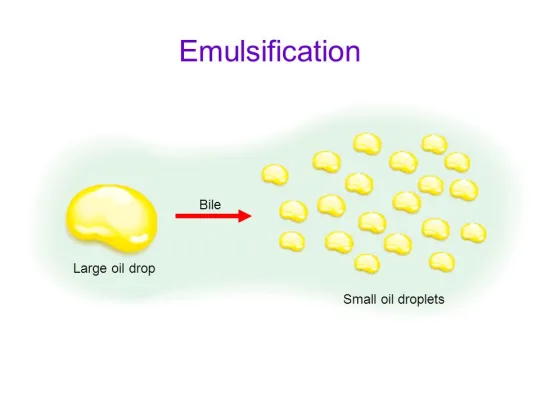
Fatty acids and glycerol molecules are small enough to cross the epithelium in the villus in the ileum. This absorption of fatty acids and glycerol is slightly different to the other products of digestion as they do not pass immediately into the blood. They are assembled immediately into structures called chylomicrons and these move into the single, blind-ended tube in the villus called a lacteal. The lacteals merge together into lymph vessels that eventually empty into the blood in the neck. (Please read my post on absorption in the small intestine to read more about this)

Digestion of Proteins: Grade 9 Understanding for IGCSE Biology 2.29
Proteins are large insoluble molecules made up of many hundreds of amino acids joined together in a long chain. So in order to obtain these molecules from our diet, the large protein must be digested (broken down) into the smaller amino acid subunits. Amino acids can be absorbed into the blood stream in the ileum, part of the small intestine.
The family of enzymes that can catalyst the digestion of proteins are called proteases.

Protein digestion happens in a two-stage process. In the first stage the large protein molecules are broken down into smaller proteins (often called polypeptides) by a protease enzyme. Pepsin is one such protease and acts in the stomach.

Remember that the food in the stomach is mixed with hydrochloric acid. This results in a very acidic liquid in the stomach (chyme). Pepsin works in the stomach and so rather unusually for a digestive enzyme, it has an optimum pH of pH 1.5 – pH2.
The second protease enzyme that you should know about is trypsin. Trypsin is made in the pancreas and so enters the duodenum soon after the stomach contents pass the pyloric sphincter (see diagram above). The acidic chyme that enters the duodenum is rapidly neutralised by hydrogencarbonate ions (an alkali) secreted in the bile and in pancreatic juice. Trypsin has an optimum pH of around pH 7.5.

As shown in the diagram above, there is a final stage to protein digestion. The actions of pepsin in the stomach and trypsin the duodenum result in small protein fragments called peptides. Many peptides are still too large to be absorbed into the blood in the ileum and so need digesting further into their constituent amino acids. Peptidase enzymes are embedded in the epithelial cell membranes in the small intestine and this final reaction completes the digestion of proteins.
Amino acids are absorbed by active transport into the blood capillaries in the villi in the small intestine.
Starch Digestion: Grade 9 Understanding for IGCSE Biology 2.29
You must remember that “Digestion” has a specific meaning in Biology. It is the term used for the process that involves the chemical breakdown of large, insoluble food molecules into smaller, simpler molecules that can be absorbed into the blood. Many of the molecules in food are polymers – that is macromolecules made from long chains of repeating subunits. Examples of dietary macromolecules include proteins, polysaccharides and fats. These molecules are too large to be able to pass into the blood in the villi of the small intestine and so the body has evolved to chemically break them down into their constituent monomers or building blocks. Digestion is the process in the alimentary canal that achieves this.
Digestion reactions are also known as hydrolysis reactions because a molecule of water is required in the reaction to break the covalent bond holding the monomers together. These reactions are all catalysed (sped up) by specific molecules called digestive enzymes.
Why do different food types need different digestive enzymes to speed up their breakdown in the digestive system?
(If you are unsure, you need to revise the way enzymes work to catalyse reactions by a “lock and key” theory?)
Digestion of Carbohydrates
Many simple carbohydrates (e.g. glucose) do not need digesting. This is because they are already small enough to be absorbed into the blood directly in the ileum (small intestine). But larger disaccharide sugars (e.g. maltose and sucrose) do need to be broken down, as do all polysaccharides (e.g starch).
The family of enzymes that break down carbohydrates are called carbohydrases.

Starch is a large polysaccharide made up of many hundreds of glucose residues linked together. It is way too big to be able to cross the epithelial lining of the small intestine and so needs to be digested. This happens in a two-stage process. Firstly there is an enzyme amylase that can catalyse the following reaction:
starch + water ——-> maltose
Amylase is made in the salivary glands and so works in the mouth. But the main region for the digestion of starch is in the duodenum. This is because amylase is also made in the pancreas.
Maltose is a disaccharide molecule made of two glucose residues joined together. Maltose itself requires digesting to its constituent glucose molecules in order to be absorbed. So the second stage in the digestion of starch involves a second enzyme, maltase that is found embedded into the epithelial lining of the ileum. Maltase catalyses the breakdown of a molecule of maltose into two molecules of glucose which can be absorbed into the blood.
maltose + water ——> glucose


